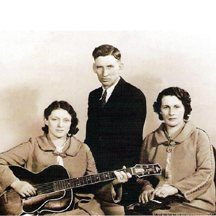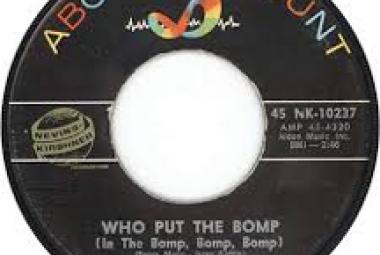The Carter Family was a traditional American folk music group that recorded between 1927 and 1956. Their music had a profound impact on bluegrass, country, Southern Gospel, pop and rock musicians as well as on the U.S. folk revival of the 1960’s. They were the first vocal group to become country music stars. Their recordings of songs such as “Wabash Cannonball”, “Can the Circle Be Unbroken”, “Wildwood Flower”, “Keep On the Sunny Side”, and “I’m Thinking Tonight of My Blue Eyes” made these songs country standards. The original group consisted of Alvin Pleasant “A.P.” Delaney Carter (1891–1960), his wife Sara Dougherty Carter (1898–1979), and his sister-in-law Maybelle Addington Carter (1909–1978). Maybelle was married to A.P.’s brother Ezra (Eck) Carter, and was also Sara’s first cousin. All three were born and raised in southwestern Virginia, where they were immersed in the tight harmonies of mountain gospel music and shape note singing. (More from Wikipedia)
For many years, I thought of A. P. Carter of the Carter Family as an incredible songwriter; his name appears as the writer for dozens if not hundreds of classic country, folk and gospel songs, but I found out later that he was actually acting more as an archivist or folklorist.
* * *
I first learned of the Carter Family when I saw original member “Mother Maybelle” Carter joined by her children, June Carter Cash (Johnny Cash’s wife by that time), Helen Carter and Anita Carter – “the Carter Sisters” – on television and on the cover of a record album that I cannot seem to locate online. The group began using the name the Carter Family following the death of family patriarch A. P. Carter in 1960, so the term the Original Carter Family is often used to refer to the legendary group.
This newer incarnation has a makeup that one would expect of a “family” singing group; there have actually been many singing groups that are composed of various members of the Carter Family. The classic line-up of the Carter Family is somewhat unusual in this regard, being made up of Alvin P. Carter and his wife Sara Dougherty Carter, plus their sister-in-law Maybelle Addington Carter; additionally, Sara and Maybelle were first cousins.
* * *
The entry on the Carter Family in Allmusic (by David Vinopal) begins: “The most influential group in country music history, the Carter Family switched the emphasis from hillbilly instrumentals to vocals, made scores of their songs part of the standard country music canon, and made a style of guitar playing, ‘Carter picking’, the dominant technique for decades. Along with Jimmie Rodgers, the Carter Family were among the first country music stars. Comprised of a gaunt, shy gospel quartet member named Alvin P. Carter and two reserved country girls – his wife, Sara [Dougherty Carter], and their sister-in-law, Maybelle [Addington Carter] – the Carter Family sang a pure, simple harmony that influenced not only the numerous other family groups of the ’30s and the ’40s, but folk, bluegrass, and rock musicians like Woody Guthrie, Bill Monroe, the Kingston Trio, Doc Watson, Bob Dylan, and Emmylou Harris, to mention just a few. It’s unlikely that bluegrass music would have existed without the Carter Family.”
* * *
When I came across the attractive album pictured above, The Famous Carter Family by the Carter Family and turned the album over on the back, I could scarcely believe what I was reading. Besides the usual credits, the listing of the songs also gave the dates when they were recorded: all within a two- or three-week period in 1928. And the songwriter in all cases was A. P. Carter. Could any one man really have written all of these incredible songs?
One of the songs, “Wildwood Flower” has perhaps the loveliest melody in all of country music. At the time, I knew the song only by reputation, and mainly because of “Wildwood Weed” (1974) – which is basically about marijuana – a #7 hit song by Jim Stafford that mentions the song: “The name of this song is ‘The Wildwood Flower’ / Now ‘The Wildwood Flower’ is an old country classic / It gained a whole new popularity / The song isn’t any more popular / But the flower is doin’ real good.” The song “Wildwood Weed” was written and originally recorded way back in 1964 by country singer and comedian Don Bowman.
But that was just the beginning. One of the A. P. Carter songs on The Famous Carter Family is so timeless that it is hard to imagine anyone writing it: “Keep on the Sunny Side”. There are three bonafide classic gospel songs: “Can the Circle be Unbroken”, “Lonesome Valley”, and “Gospel Ship”. Another song was one I knew as a Woody Guthrie number, “Worried Man Blues”. The other songs I was not familiar with but quickly learned to love as much as the others. I gathered up a few more Carter Family albums and learned what I could about them.
I started correcting people that the song “Will the Circle be Unbroken” is actually named “Can the Circle be Unbroken”. Eventually I came across the “Will” title so much that I decided that I needed to look it up. It turns out, according to Wikipedia, that “Can the Circle be Unbroken” was reworked by A. P. Carter from the hymn “Will the Circle be Unbroken?” that dates from 1907.
* * *
This would be a good time to relate my recent purchase of a one-of-a-kind, three-disc album called Will the Circle be Unbroken (1972). Unlike nearly all of the other rock and country collaborations that I know about, in this case the rockers hand the keys off to country music legends and let them drive. Ostensibly (or even technically) a Nitty Gritty Dirt Band album, Wikipedia calls the album a “collaboration from many famous bluegrass and country-western players, including Roy Acuff, ‘Mother’ Maybelle Carter, Doc Watson, Earl Scruggs, Merle Travis, Pete ‘Oswald’ Kirby, Norman Blake, Jimmy Martin, and others. It also introduced fiddler Vassar Clements to a wider audience.”
Wikipedia continues: “The album’s title . . . reflects how the Nitty Gritty Dirt Band was trying to tie together two generations of musicians. Nitty Gritty Dirt Band was a young country-rock band with a hippie look. . . . The other players were much older and more famous from the forties, fifties and sixties, primarily as old-time country and bluegrass players. Many had become known to their generation through The Grand Ole Opry. However, with the rise of rock-and-roll, the emergence of the commercial country’s slick ‘Nashville Sound’, and changing tastes in music, their popularity had waned somewhat from their glory years.
“Every track on the album was recorded on the first or second take straight to two-track masters, so the takes are raw and unprocessed. Additionally, another tape ran continuously throughout the entire week-long recording session and captured the dialog between the players. On the final album many of the tracks — including the first track — begin with the musicians discussing how to do the song or who should come in where.”
For any rock music fan who wants to learn about early country music, I cannot think of a better place to start.
* * *
At a later date, I decided to look in Wikipedia to see if they had a list of songs that were written by A. P. Carter. Well, they did, but it was not at all what I expected: There are only 4 songs on the list. This was the real story according to the Wikipedia article on A. P. Carter: “Carter was known for traveling extensively throughout the country and collecting and blending songs, particularly from Appalachian musicians. Some of the songs became so closely identified with A. P. Carter that he has been popularly, but mistakenly, credited with writing them. For example, ‘Keep on the Sunny Side of Life’ was published in 1901 with the words being credited to Ada Blenkhorn and the music credited to Howard Entwisle, and ‘The Meeting in the Air’ has been published giving credit for music and words to I. G. Martin.”
(February 2015)
* * *
Items: The Carter Family















